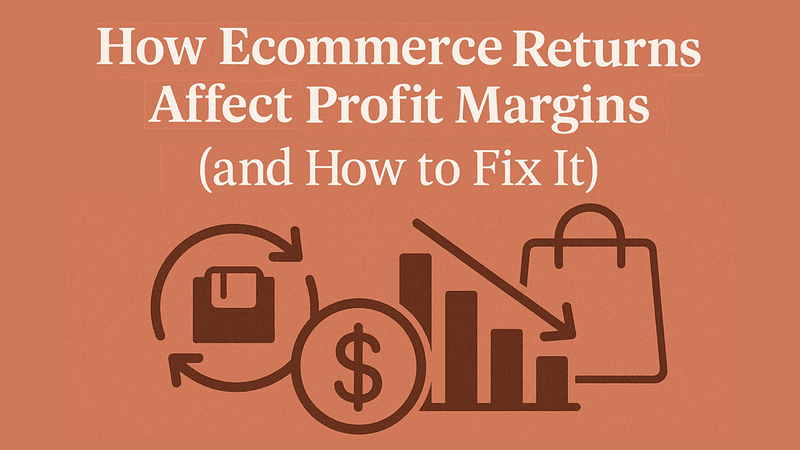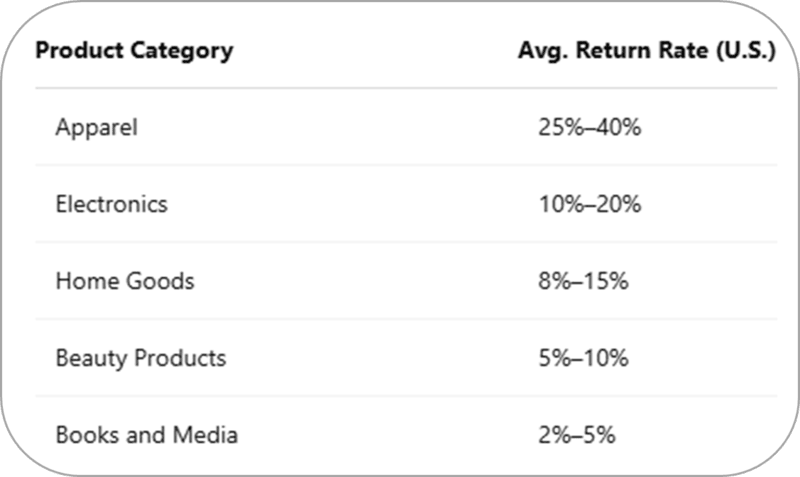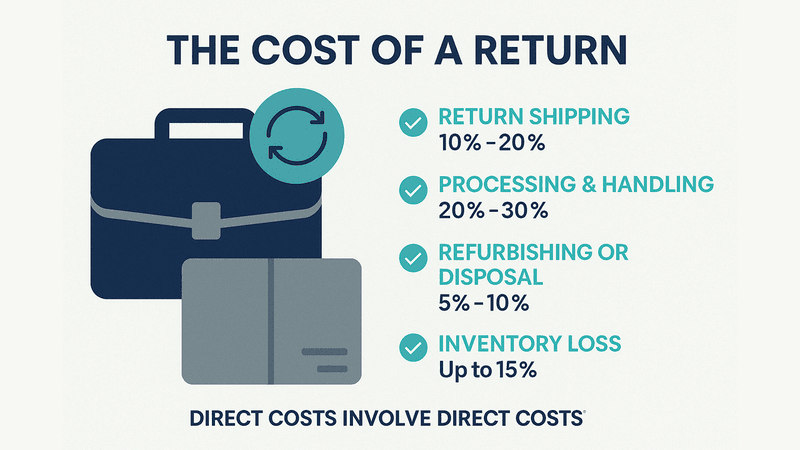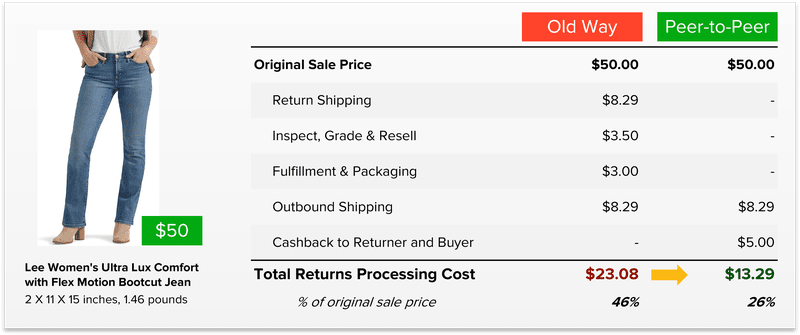How Ecommerce Return Rate Affects Profit Margins (and How to Fix It)

Last updated on April 17, 2025

In this article
 7 minutes
7 minutes
- A Silent Margin Killer
- The Cost of a Return: What’s Really at Stake
- Breaking Down the Ecommerce Return Rate
- Why Returns Crush Profit Margins
- 7 Ways to Fix the Problem and Improve Profit Margins
- The Cost of a Return
- Quick Checklist: 10 Return Policy Changes to Boost Profitability
- Summary: Better Returns, Better Margins
- Frequently Asked Questions
A Silent Margin Killer
Returns are the elephant in the ecommerce warehouse. Whether you run a small DTC brand or a sprawling omnichannel enterprise, returns are eating into your profit margins more than you probably realize. In the U.S. alone, Forbes reported that 16.9% of total retail sales were returned in 2024, that’s over $890 billion in retail merchandise walking right back out the door.
As online shopping continues to outpace physical stores, ecommerce return rates have skyrocketed. On average, online purchase returns fall between 15% and 30%, with apparel, electronics, and home goods among the highest product categories. And while customers return items for all kinds of reasons, from fit issues to buyer’s remorse, the costs associated with ecommerce returns are real, and rising.
Let’s dive into how returns affect profit margins and what ecommerce businesses can do to fix it.
The Cost of a Return: What’s Really at Stake
Every return sets off a domino effect of expenses: reverse logistics, restocking, labor, refund processing, and potential lost sales. Unlike brick-and-mortar stores, where a customer might return an item directly to a shelf, ecommerce stores must process returns through multi-step operations, often involving warehouses, multiple systems, and several sales channels.
And that’s just the beginning. There’s the damage risk during return shipping, lost packaging, and in many cases, items that can’t be resold at full price, or at all. This is especially true in high-return categories like fashion, where returned apparel often needs to be inspected, re-tagged, or discounted.
On top of that, return fraud is a growing concern for online retailers. Some customers return used or counterfeit goods, while others exploit generous free return shipping policies by sending back products they never intended to keep.
The result? Lost revenue, damaged margins, and a massive drain on business operations.
Breaking Down the Ecommerce Return Rate
The ecommerce return rate varies widely depending on what you sell and who you sell to. Here’s a snapshot of the average ecommerce return rate for a few categories:

Understanding your category’s benchmark is the first step in evaluating your ecommerce store’s performance. But more importantly, you need to analyze your own return data to understand what’s driving returns and how you can reduce them.
Why Returns Crush Profit Margins
Returns affect ecommerce profit margins in multiple ways:
- High Reverse Logistics Costs: Shipping items to the customer and then back again is costly, especially with free return shipping.
- Inventory Depreciation: Returned products lose value, especially seasonal or trend-driven goods.
- Operational Bottlenecks: Labor-intensive returns workflows slow down fulfillment and drain warehouse productivity.
- Customer Churn: A poor post-purchase experience can push customers toward competitors.
- Lost Future Purchases: Refunds instead of exchanges can mean a permanently lost sale.
And if you’re offering instant refunds or free returns with no questions asked, your ecommerce business may be rewarding returns without a strategy in place to recover that revenue or retain the customer.
7 Ways to Fix the Problem and Improve Profit Margins
1. Upgrade Product Pages with Detailed Descriptions
Many returns happen because the customer expected something different than what they received. Ecommerce businesses must close this expectation gap by improving product pages. That means:
- Multiple high‑res images from different angles
- User‑generated content (UGC) such as product reviews and comments
- Size guides and fit recommendations
- Augmented reality try‑ons (especially for eyewear, shoes, and home decor)
When online customers are better informed, they make better choices and return less often.
2. Encourage Store Credit and Exchanges Over Refunds
Instead of processing refunds every time customers return items, offer them value in the form of store credit or exchanges. Tools like Loop, ReturnGO, and others help ecommerce brands automate this process and incentivize exchanges with:
- Bonus credit (e.g., “Get 10% extra when choosing store credit”)
- Faster shipping on exchanges
- Easy one‑click swaps
This keeps more revenue within your ecosystem and encourages future purchases.
3. Use Returns Management Software
The right technology can help you manage returns at scale. Returns management software automates:
- Return eligibility checks
- Label generation
- Refund processing
- Customer communication
It also collects valuable return data that helps identify trends, like frequently returned SKUs or issues with specific fulfillment centers. This data is crucial for optimizing operations and enhancing customer satisfaction.
4. Implement Smart Segmentation in Return Policies
Not all returns are equal, and not all customers should be treated the same. Use customer data to create dynamic return policies:
- Reward loyal customers with extended windows and free returns
- Apply stricter terms to serial returners or high‑risk categories
- Offer return in‑store options for hybrid shoppers
This lets you manage returns while still delivering a seamless customer experience to your best buyers.
5. Proactively Manage Customer Expectations
Set the tone early in the customer journey. Communicate return policies clearly on product pages, in the cart, and at checkout. Let potential customers know:
- What qualifies for a return
- How to ship items securely
- Whether they’ll receive instant refunds, exchanges, or store credit
A clear policy improves overall customer satisfaction and reduces post-purchase surprises.
6. Use Data to Improve Inventory and Sourcing
Returns offer insights far beyond refunds. By analyzing your ecommerce return statistics, you can:
- Spot product defects or design flaws
- Discover misleading product descriptions
- Flag suppliers with inconsistent quality
Smarter sourcing reduces your return rate and protects your profit margins.
7. Reframe Returns as a Competitive Advantage
Most online merchants see returns as a necessary evil. But leading ecommerce brands are turning returns into retention tools:
- Hassle‑free returns policies build trust and boost conversion
- Quick refunds and transparent updates keep customers informed and happy
- Personalized experiences based on purchase history improve the customer journey
In short, optimizing returns helps improve customer loyalty and drive more revenue.
The Cost of a Return

What $1 in Returned Goods Actually Costs Your Ecommerce Business
- $0.20 – Reverse shipping
- $0.25 – Restocking and handling
- $0.10 – Depreciation/damage
- $0.15 – Lost future purchases
- $0.05 – Refund processing
- $0.10 – Waste/sustainability impact
True Cost = $0.85 for every $1 in returns
(Source: Industry averages based on ReturnLogic, ReturnGO, and Flex Logistics reports)
Quick Checklist: 10 Return Policy Changes to Boost Profitability
- Post return eligibility clearly on product pages
- Offer free return shipping only to VIPs
- Use restocking fees for high‑risk items
- Provide store credit incentives for exchanges
- Enable returns in‑store for local customers
- Segment policies by customer type
- Automate the returns process with software
- Analyze return reasons monthly
- Flag repeat returners with CRM tools
- Highlight sustainability initiatives on the returns page
Summary: Better Returns, Better Margins
Managing the ecommerce return rate is no longer just about cutting losses, it’s about building a sustainable, profitable business. With smarter return policies, better product pages, more efficient operations, and a customer‑first mindset, ecommerce businesses can turn returns into an engine for growth, not just a cost center.
Returns will always be a part of the ecommerce experience. But when you treat them as a strategic advantage, and not just an annoying afterthought, you’ll see stronger profit margins, more revenue, and happier, more loyal customers.
Frequently Asked Questions
What is the average ecommerce return rate?
The average ecommerce return rate is approximately 16.9%, though it can reach 60% or more in certain categories such as luxury apparel. This highlights the importance of managing returns effectively in different product sectors.
How can I reduce return rates for my ecommerce business?
To effectively reduce return rates for your ecommerce business, enhance your product descriptions and visuals, utilize AR and 3D technology, and provide detailed sizing charts along with customer reviews. This approach will help set proper expectations for your customers and minimize dissatisfaction.
What are the direct costs associated with ecommerce returns?
The direct costs associated with ecommerce returns primarily involve reverse logistics, processing fees, and lost profit margins, which can total between 20% and 65% of the item’s original value. Understanding these costs is crucial for managing return policies effectively.
How can returns management software help my business?
Returns management software can significantly improve customer satisfaction by automating the returns process, providing timely updates, and utilizing data for efficient return approvals. This leads to a smoother experience for both your business and your customers.
What is return fraud and how can I prevent it?
Return fraud, which includes tactics like receipt fraud and wardrobing, can be prevented through digital tracking of return history, implementing AI to identify fraud patterns, and offering store credit instead of cash refunds. These measures will help safeguard your business from potential losses.

Up to 64% Lower Returns Processing Cost


